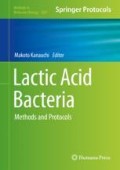Abstract
Isolation of lactic acid bacteria (LAB) is the first and crucial step to study possible roles of LAB in the environment, especially in food fermentation. This is also important to use the organisms for further application. LAB are diverse bacterial group and have diverse growth characteristics. Culture condition of LAB is thus varied, and selection of a suitable culture medium is essential for the purposes. Identification is also an important step, since certain desirable and undesirable characteristics are shared within species. Identification was classically carried out by phenotypic characteristics but is usually performed by DNA sequence-based approaches. 16S rRNA gene sequencing is generally used for identification, and sequencing of housekeeping genes is used when needed. In addition, identification based on whole-genome sequence similarities is becoming common. Here we describe isolation and identification of LAB briefly.
Access this chapter
Tax calculation will be finalised at checkout
Purchases are for personal use only
References
Endo A, Futagawa-Endo Y, Dicks LM (2009) Isolation and characterization of fructophilic lactic acid bacteria from fructose-rich niches. Syst Appl Microbiol 32:593–600
Stackebrandt E, Ebers J (2006) Taxonomic parameters revisited: tarnished gold standards. Microbiol Today 33:152–155
Mattarelli P, Holzapfel W, Franz CM, Endo A, Felis GE, Hammes W, Pot B, Dicks L, Dellaglio F (2014) Recommended minimal standards for description of new taxa of the genera Bifidobacterium, Lactobacillus and related genera. Int J Syst Evol Microbiol 64:1434–1451
Felis GE, Dellaglio F, Mizzi L, Torriani S (2001) Comparative sequence analysis of a recA gene fragment brings new evidence for a change in the taxonomy of the Lactobacillus casei group. Int J Syst Evol Microbiol 51:2113–2117
Naser SM, Dawyndt P, Hoste B, Gevers D, Vandemeulebroecke K, Cleenwerck I, Vancanneyt M, Swings J (2007) Identification of lactobacilli by pheS and rpoA gene sequence analyses. Int J Syst Evol Microbiol 57:2777–2789
Goris J, Konstantinidis KT, Klappenbach JA, Coenye T, Vandamme P, Tiedje JM (2007) DNA-DNA hybridization values and their relationship to whole-genome sequence similarities. Int J Syst Evol Microbiol 57:81–91
Richter M, Rossello-Mora R (2009) Shifting the genomic gold standard for the prokaryotic species definition. Proc Natl Acad Sci U S A 106:19126–19131
Tanizawa Y, Fujisawa T, Kaminuma E, Nakamura Y, Arita M (2016) DFAST and DAGA: web-based integrated genome annotation tools and resources. Biosci Microbiota Food Health 35:173–184
Yoon SH, Ha SM, Lim J, Kwon S, Chun J (2017) A large-scale evaluation of algorithms to calculate average nucleotide identity. Antonie Van Leeuwenhoek 110:1281–1286
Meier-Kolthoff JP, Auch AF, Klenk HP, Goker M (2013) Genome sequence-based species delimitation with confidence intervals and improved distance functions. BMC Bioinformatics 14:60
Richter M, Rossello-Mora R, Oliver Glockner F, Peplies J (2016) JSpeciesWS: a web server for prokaryotic species circumscription based on pairwise genome comparison. Bioinformatics 32:929–931
Parks DH, Imelfort M, Skennerton CT, Hugenholtz P, Tyson GW (2015) CheckM: assessing the quality of microbial genomes recovered from isolates, single cells, and metagenomes. Genome Res 25:1043–1055
De Man JC, Rogosa M, Sharpe ME (1960) A medium for the cultivation of lactobacilli. J Appl Bacteriol 23:130–135
Rogosa M, Mitchell JA, Wiseman RF (1951) A selective medium for the isolation and enumeration of oral and fecal lactobacilli. J Bacteriol 62:132–133
Terzaghi BE, Sandine WE (1975) Improved medium for lactic streptococci and their bacteriophages. Appl Microbiol 29:807–813
Dicks LMT, Van Vuuren HJJ, Dellaglio F (1990) Taxonomy of Leuconostoc Species, Particularly Leuconostoc oenos, as Revealed by Numerical Analysis of Total Soluble Cell Protein Patterns, DNA Base Compositions, and DNA-DNA Hybridizations. Int J Syst Evol Microbiol 40:83–91
Garvie EI (1967) Leuconostoc oenos sp.nov. J Gen Microbiol 48:431–438
Torriani S, Felis GE, Dellaglio F (2001) Differentiation of Lactobacillus plantarum, L. pentosus, and L. paraplantarum by recA gene sequence analysis and multiplex PCR assay with recA gene-derived primers. Appl Environ Microbiol 67:3450–3454
Endo A, Irisawa T, Futagawa-Endo Y, Sonomoto K, Itoh K, Takano K, Okada S, Dicks LM (2011) Fructobacillus tropaeoli sp. nov., a fructophilic lactic acid bacterium isolated from a flower. Int J Syst Evol Microbiol 61:898–902
Overbeek R, Olson R, Pusch GD, Olsen GJ, Davis JJ, Disz T, Edwards RA, Gerdes S, Parrello B, Shukla M, Vonstein V, Wattam AR, Xia F, Stevens R (2014) The SEED and the Rapid Annotation of microbial genomes using Subsystems Technology (RAST). Nucleic Acids Res 42:D206–D214
Author information
Authors and Affiliations
Corresponding author
Editor information
Editors and Affiliations
Rights and permissions
Copyright information
© 2019 Springer Science+Business Media, LLC, part of Springer Nature
About this protocol
Cite this protocol
Endo, A., Tanizawa, Y., Arita, M. (2019). Isolation and Identification of Lactic Acid Bacteria from Environmental Samples. In: Kanauchi, M. (eds) Lactic Acid Bacteria. Methods in Molecular Biology, vol 1887. Humana Press, New York, NY. https://doi.org/10.1007/978-1-4939-8907-2_1
Download citation
DOI: https://doi.org/10.1007/978-1-4939-8907-2_1
Published:
Publisher Name: Humana Press, New York, NY
Print ISBN: 978-1-4939-8906-5
Online ISBN: 978-1-4939-8907-2
eBook Packages: Springer Protocols

